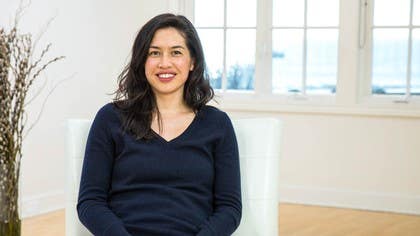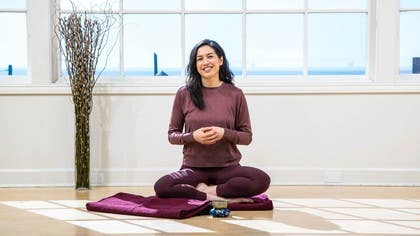Description
About This Video
Transcript
Read Full Transcript
Shammata is really the foundational practice of Tibetan Buddhism. It can also be called mindfulness practice. But the mindfulness practice, the Shammata part of the meditation, is really inseparable from the Vipassana part of the meditation. So Shammata, mindfulness, Vipassana, awareness. The two work together.
It's like strengthening the mind, strengthening the focus, relaxing, expanding. So we really strengthen the muscle of our attention through that process of close placement, focusing on the breath, and then allowing that attention, allowing that concentration to dissolve. So when we put those two things together, we really start to produce a quality of awareness that's naturally clear, attentive, focused, and also spacious. So I studied in the Kagu lineage. Chögyam Trungpa Rinpoche is the teacher that brought the Kagu lineage to North America.
So he also really modernized it for the Western mind. So it's traditional, and it's also taking the essence of that Dharma and creating a container where it can be communicated to a Westerner. So that was really Trungpa Rinpoche's great work. So my teacher is from his lineage. Technique matters a lot, although one could say that the ultimate technique is no technique.
So it's a bit of a paradox, and yet in order to even get into the practice, we have to have some type of container. So we use the breath as the focal object, we use the body as a focal object, or rather the breath within the body as a focal object, to kind of corral our attention. So in the beginning of the practice, it's really just about taming and training our awareness, which we then mix with relaxation. So it's not too tight, it's not too loose, it's a little bit of both, it's a bit like tuning a guitar. That's the old metaphor we use in the tradition is, how do you tune a guitar not too tight, not too loose.
So it's really finding that middle way. So the middle way analogy applies to all of these practices as well, so finding that sense of relaxation and also awareness, also focus. So those qualities come together naturally in the practice. So there is some technique, it's important, but we also drop it at a certain point. But then we return to it.
So it's in that letting it go, returning to it, letting it go, returning to it, that we start to develop those qualities within our mind that are always already present. Discipline is very important, but it's the right type of discipline. So if we're too hard on ourselves, then we'll feel discouraged from practicing. And yet if we don't try at all, then we won't practice at all. So it's really rousing that sense of care to say, all right, I'm going to show up to the cushion today, no matter how I feel, tired, happy, sad, whatever your mind state is, you show up and you do the practice.
So the discipline begins to invite in that unconditional acceptance. So without the discipline, there's no practice of acceptance. But it's the right type of discipline. It's not, oh, I'm a bad person for not doing my practice. That's judgment.
That's not discipline. Sangha is one of the three jewels. So there's the Buddha, the Dharma, and the Sangha. We can't do this practice without a community of practitioners that also share similar beliefs and values. So whether that's community on yoga, any time community and where you live, people that share the values of what you're trying to do, indispensable.
And also when things come up for you in the practice to have a teacher to relate to, but really having a community of people that also are doing something similar with themselves, it creates camaraderie, it creates community, creates interdependence. So very important, Sangha. How has meditation helped me in my life? Number one is I feel a sense of intimacy with myself. That unconditional presence that no one can take away is for me is the real gift of meditation.
It's we got this, rain, drought, whatever, happy, sad, there's a sense of presence that's continuous and unconditional. What does meditation show me about my mind that it's limitless from good, bad, happy and sad? I keep repeating this, but it's true. There are no limits to what can come up on the cushion. And I feel like the practice gives you a way to develop some equanimity towards that which arises.
And again, a sense of humor, a sense of levity, lightness, because what you'll notice in the practice is that what arises for you is not solid, it's not fixed, it keeps changing. And to realize that that ever present, there is an ever present state of awareness that underlies all the phenomena. So it's almost like the bottom of the ocean and the phenomena and all of that are like the waves. So we take refuge in this practice at a much deeper level, and we allow the mind to just be what it is. We stay with that technique, we keep coming back to the focal sense of the breath and the body, and yet you are able to observe the contents of your mind in a much different way.
It gives you a sense of perspective, there isn't as much identification with all of your thoughts and emotions, so it really creates more space. That's the best way to put it. Who should not meditate? I think, again, anyone can meditate. It doesn't preclude anyone.
Everyone's invited to come as they are with whatever level of self-awareness, self-practice, self-actualization, it's 100% inclusive practice. It just is a way of developing intimacy with your own mind, so anyone can do it. I have insights on and off the cushion, but on the cushion I try to stay true to the technique so that there's a real crispness when I complete the practice. The insights can be very clear. So the practice itself is just stay with the focal object, just stay with the technique and don't indulge the insights that arise, you simply come back to the experience of being in the body.
That way when you complete the practice, whatever arises is clear. Staying true to the technique will really enhance the post-meditation experience. So whatever insights that arise after you get up from the cushion will be clearer, will have more impact. You'll also be less emotional about it, hopefully, because really the process of meditation is intended to also purify the energetic body. So all of it is creating a deeper baseline of equanimity from which you can then glean these insights.
Shamata Meditation
Comments
You need to be a subscriber to post a comment.
Please Log In or Create an Account to start your free trial.













